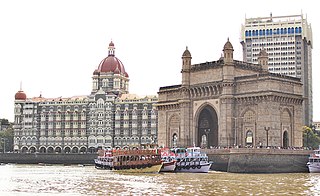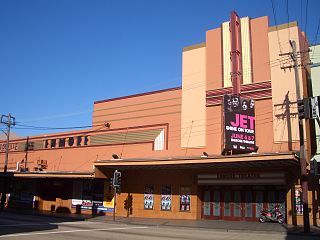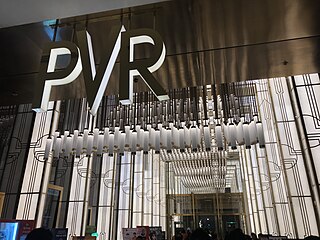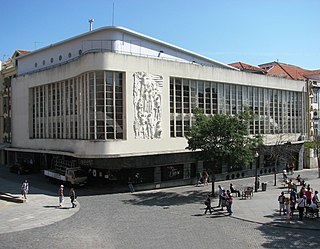
The Empire, Leicester Square is a cinema currently operated by Cineworld on the north side of Leicester Square, London, United Kingdom.

The Odeon Luxe Leicester Square is a prominent cinema building in the West End of London. Built in the Art Deco style and completed in 1937, the building has been continually altered in response to developments in cinema technology, and was the first Dolby Cinema in the United Kingdom.

The Regal Cinema is an Art deco movie theatre located at Colaba Causeway, in Mumbai, India. Built by Framji Sidhwa, the first film to be aired at the Regal was the Laurel and Hardy work The Devil's Brother in 1933.

A resident of Mumbai is called a Mumbaikar. People prefer to stay close to a railway station for easy access to the metropolis. Many city-dwellers lead a fast-paced life with very little time for other activities owing to a significant amount of time spent on daily commuting.

Metro INOX Cinemas is an Art Deco Heritage grade IIA multiplex Movie theatre in Mumbai, India built in 1938. It was built and originally run by Metro-Goldwyn-Mayer (MGM). The main architect of the cinema was Thomas W. Lamb of New York City, and D. W. Ditchburn of Mumbai was the associate architect. It was one of the main sites targeted in the 2008 Mumbai attacks.

The Rex is a cinema in the town of Berkhamsted, Hertfordshire, England. Designed in the art deco style by David Evelyn Nye in 1936, the cinema opened to the public in 1938. After 50 years of service, the cinema closed in 1988 and became derelict. The building was listed Grade II by English Heritage, and following a campaign to save the Rex by a local entrepreneur, the cinema re-opened to the public in 2004.

The Enmore Theatre is a theatre and entertainment venue in Enmore, New South Wales, Australia. It was built in 1908. It is located at 118–132 Enmore Road in Newtown, in the inner west of Sydney's suburbs. It was first opened in 1912 as a photo-play theatre. It was run by a well-known theatre family at the time, the Szarka Brothers. Today's Enmore Theatre is the longest running live theatre in Sydney, hosting concerts, comedians, plays and all forms of performance. The theatre is considered a medium-sized venue that holds 1,700 people when fully seated and 2,500 when seats are removed, and all attendees are standing. It has hosted many international bands including a performance by Bob Dylan. The venue's Inter-war Art Deco style, dating from its 1937 remodelling by Charles Bohringer, is protected by its listing as a local heritage item by Inner West Council. The Enmore theatre has had many renovations and shifts of ownership. Today it is owned by Century Venues and has hosted a range of arts from photographic, performing arts, music and motion picture. The theatre's listing in the Office of Environment and Heritage states that the building "illustrates the development of suburban theatres in the late 1930s and early 1940s and is of social significance for the local community.″ It is the only theatre in Sydney from the Art Deco movement in its original condition. From cinema use to concerts, today it is used for various reasons.

Chennai architecture is a confluence of many architectural styles. From ancient Tamil temples built by the Pallavas, to the Indo-Saracenic style of the colonial era, to 20th-century steel and chrome of skyscrapers. Chennai has a colonial core in the port area, surrounded by progressively newer areas as one travels away from the port, punctuated with old temples, churches and mosques.

PVR INOX Ltd, formerly known as PVR Cinemas, is an Indian multiplex chain based in Mumbai. It was formed as a result of the merger between PVR Cinemas and INOX Leisure Multiplex. PVR pioneered the multiplex revolution in India by establishing the first multiplex cinema in 1997 at Saket, New Delhi. In 2022, PVR Cinemas achieved the milestone of completing 25 years in the business. As of December 2023, PVR Inox has 1747 screens across 359 properties in 114 cities.
The Whiteladies Picture House is a cinema on Whiteladies Road in Clifton, Bristol, England.

The State Theatre is a heritage-listed theatre, located at 47-51 Market Street, in the Sydney central business district in the City of Sydney local government area of New South Wales, Australia. The theatre was designed by Henry Eli White with assistance from John Eberson and built between 1926 and 1929. It hosts film screenings, live theatre and musical performances, and since 1974 it has been the home of the annual Sydney Film Festival. It is also known as State Building and Wurlitzer Organ. The property is privately owned. It was added to the New South Wales State Heritage Register on 2 April 1999.

The Cinema Batalha is a Portuguese cinema and concert venue in civil parish of Cedofeita, Santo Ildefonso, Sé, Miragaia, São Nicolau e Vitória, municipality of Porto. Originally known as the Salão High-Life, it was moved from Boavista by its owners to its current location, and rebuilt by architect Artur Andrade in the Art-Deco style, re-inaugurated on 3 June 1947. After many years of success, the building and the cinema began losing customers, and was closed in 2003.
The architecture of Mumbai blends Gothic, Victorian, Art Deco, Indo-Saracenic & Contemporary architectural styles. Many buildings, structures and historical monuments remain from the colonial era. Mumbai, after Miami, has the second largest number of Art Deco buildings in the world.

Warren Theatres was a movie theater chain based in Wichita, Kansas, United States. While the company was founded by Bill Warren, he sold ownership of most of the Warren Theatres locations to Regal Entertainment Group in 2017. The sale excluded two theaters that were in development and the Palace Theatre in Springfield, Missouri.

Many heritage structures are found in Mumbai, India.

Vue West End is a nine-screen cinema complex in Leicester Square, London, operated by Vue Cinemas. The multiplex was constructed in 1993 on the site of what was previously the Warner West End cinema.

The Victorian Gothic and Art Deco Ensembles of Bombay is a collection of 19th-century Victorian Revival public and 20th-century Mumbai Art Deco private buildings in the Fort precinct of Mumbai. This ensemble was declared a UNESCO World Heritage Site in 2018.

The Rio Cinema is a Grade II listed independent Art Deco cinema in Dalston, east London. It is a popular independent cinema located on Kingsland High Street, with a history stretching back over 100 years. The Rio added a second screen in the unused basement space in December 2017.

The Art Deco in Mumbai, India style is a notable feature of the architecture of the city. It was used primarily for office buildings, residences and movie theaters, during a period when India was part of the British Empire. On 30 June 2018, an ensemble of such buildings were officially recognized as a World Heritage site by the UNESCO World Heritage committee held in Bahrain as the Victorian and Art Deco Ensemble of Mumbai.























